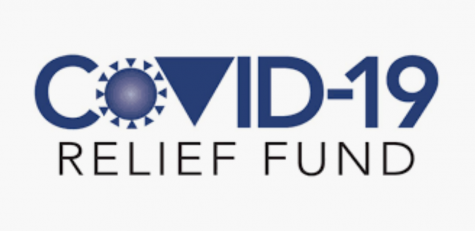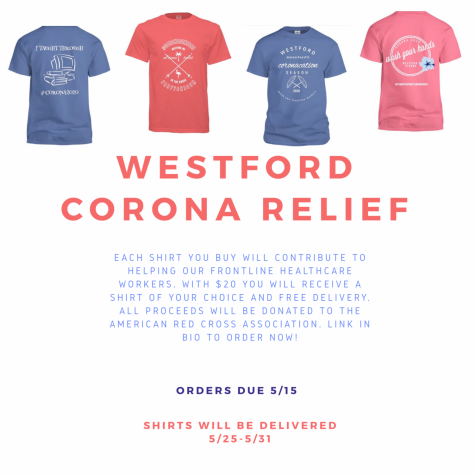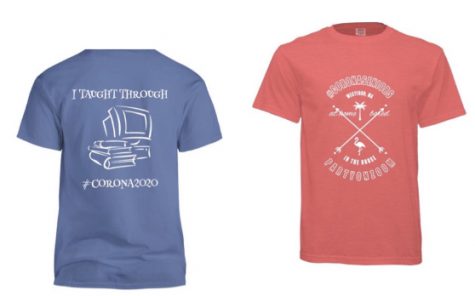Ten steps to self-start a fundraiser
Starting a COVID-19 Relief Fund
May 9, 2020
With the COVID-19 global pandemic locking us all in our homes, it’s easy to feel powerless quarantined at home. However, you can actually help out from your own room with retail fundraisers.
I am Koko Xu, a junior at Westford Academy. A friend Mia Tabor and I have raised nearly $1000 in less than two weeks from t-shirt sales. Moreover, we have explored and summarized all the tricks and secrets to make your retail fundraiser successful!

The COVID-Relief Fund helps countless families and individuals.
Many people think it’s easy starting a fundraiser, and that misinterpretation leads to unfair conclusions and under-appreciation for Relief Efforts everywhere. We have personally hit all the roadblocks, climbed all the obstacles, and made all the mistakes in the process, teaching us lesson upon lesson about self-started fundraisers. Since we first started a student-run fundraiser for charity in March 2020, other students have responded to our lead in the movement. We are very proud that our initiative has inspired our peers to follow in our footsteps, but we are also fearful that their efforts will be discouraged by the challenges of the process.That is why we have decided to share all of our experiences and make sure those who want to help, can.
1. What Problem Are You Solving?
The first common mistake people make is they do not choose their charity carefully. This means simply the “COVID Fund” is not attractive to your customers. Let them know exactly how, why, and when you will help!
Ex. For our “Westford Corona Relief Fund”, we are selling custom t-shirts to the Westford community and donating the money. That’s “how”. We are focusing on helping the American Red Cross Association. This principle sets us apart in the way that the coronavirus is mostly non-lethal, but those who need help from the ARC are on the brinks of death. The ARC is an organization that brings blood to those in need, and with all the buzz around COVID relief, their efforts are being neglected. That’s “why”. We set an order deadline early on, 5/15, as well as delivery dates. That’s the “when”.

2. Who Are You Selling To?
I cannot emphasize this enough: Start small! One of the most common mistakes of self-starters is that they always want to go big or go home. That is not practical at all. Facebook’s first target consumers were only people with valid Harvard IDs; Airbnb’s first target consumers were thirty homes in San Francisco; DoorDash’s first target consumers were Stanford students living in Palo Alto. The reason to start with a small consumer target is that in order for your platform to succeed, you must have people talking about you. The word will not spread if your first ten customers are all over Massachusetts, but it will if they’re ten Westford Baseball players. Start small, provide excellent customer support, and tap into new customer groups once you’ve secured your current one.
Ex. Our first two t-shirt models were strictly for Westford Academy seniors. Our logo was #coronaseniors, and the reason is that seniors were the most affected by quarantine. Once we’ve secured baseline orders from seniors, we expanded to all WA students with a new design. With the momentum, we tapped into all the Westford Public Schools staff with #proudwestfordeducator. Finally, we are receiving orders from the regular townspeople of Westford. Because we scaled steadily, we were able to perfect our products along the way and keep up with customer support, thus maintaining manageable growth.
3. Make A Great Product!
It’s in the title. Making a product is a crucial part both financially and for your platform. If you make the perfect product, marketing down the road will be so much easier. Similarly, if you make a product at low cost, your price will be unmatched by competitors. If you are going homemade, keep in mind your sales will be less than factory-made. On the bright side, your cost will be almost nothing! If you are going mass-production, make sure to pick a reliable and cost-efficient provider! Call them, ask them questions, ask for discounts for charity, and get in touch! Take your time designing your product!
Ex. We at Westford Corona Relief picked Uberprints.com for our shirt design provider. This is because: They are a large, legitimate organization with good reviews. They are in business despite quarantine. They have exceptional customer support. Their website is easy to use. We took the risk of placing the selling price below the cost because the cost per shirt decreases as more orders come in. It was a tough decision and a leap of faith, but it worked out in the end.
4. Do Market Research!
Market research sounds like some fancy term, but it’s really just asking people if they like your product. There are, however, a few rules to stick to when doing this. First, never ask for advice from family and close friends. This sounds counterintuitive, but those closest to you will never give real, hurtful advice. You should email your teachers, do a poll on your Instagram story, DM everyone individually who voted, and ask them why they chose that design. Real beneficial advice only comes from uncomfortable one-on-one interviews.
Ex. With Westford Corona Relief we welcomed criticism. Once we built a social media platform, we had frequent polls and interviewed many strangers for advice. Instead of asking “do you like this shirt?”, which is a question that most will answer without thinking, we asked, “are you willing to pay money for this shirt?”. This question is a lot more practical for market research and helped us narrow down designs effectively.
5. Build A Social Media Presence.
Now, you can finally get started with putting the word out. I recommend Instagram as the main platform, as its many features are compatible with businesses. If you are skilled with website design, that can never hurt. Building a social media presence requires a lot of work. First, you must have followers. This comes from sharing the account on your personal page, following hundreds of people every day, and putting out new content consistently. Remember, don’t just follow your friends, find their parents. Adults are more likely to donate, so finding an adult on Instagram, then following all of their followers, is an efficient way to get recognition among actual consumers.
Ex. I had the benefit of running an already established social media page, WA Live Sports, so I had multiple ways to get the word out. However, after the initial burst of page activity in the first three days, I had to go follow-for-follow, starting with students, parents, follower lists of WA, JV Fletcher, and Burton Grills even. Getting creative in reaching potential consumers is key! After all the social media advertisements, I made sure to post at least once a day with new content. This included creating content like expense-revenue charts, polling on potential designs, informational pamphlets on why people should donate, and updates on our fundraising goals. Again, get creative.
6. Setup Ordering System
As you’re setting up your social media page and getting recognition, start preparing an order form. This is most easily done with google forms. Make sure to set email and delivery addresses as requirements so you can contact your customers. Put the shortened form link in your Instagram bio and set a way of payment. Cash, check, and Venmo are all easy to collect. Make sure you link your google form to a spreadsheet so you can check off who has paid and who hasn’t. Always send out an order confirmation email the same day as the customer fills out their form. This builds credibility and increases customer satisfaction dramatically.
Ex. We set up our google forms just like I described. I would refresh the spreadsheet every other hour and if a new order is in I check my Venmo to see if they’ve paid yet. If they have not paid after five days I send out another email to remind them. In the emails we send out, we pronounced our appreciation of their help toward our cause and asked them to share our platform with a friend. These details made our platform more legit and paved the way for good referrals.
7. Adjust Your Products With More Market Research.
At this point, you are probably a week into your fundraising with a few orders under the belt. Now, you want to make sure people still like your product by putting out new polls and designs. If one product isn’t selling well, it is likely it has “ran dry”. This means you need to make a new product or a different version (color, graphic etc.) of your product to keep things going. Remember to not ask people who already bought your product what they think, but ask those who haven’t what is preventing them from buying. Your most common answers will be “I’m broke” or “I don’t need this”. To respond to the first, ask them to show your product to their parents and friends to see if they’re interested. To respond to the second, remind them that it’s for charity and their effort is crucial to your goal.
Ex. Our shirts have been tweaked many times. Small changes like changing a bottle clipart to a flamingo, switching the order of two words, changing from “Westford Teachers” to “Westford Educators” etc. Ask, adapt, react, ask. It’s never too late to perfect your products. Through these changes, we’ve tackled some hesitant customers and made them feel like their voices are heard.
8. Finally Time To Expand!
If you created a well-liked product and followed the previous steps, you probably have quite a few orders. Now, it’s finally time to scale and expand. This means new social media advertisements, finding new target consumers, reaching out to new organizations, and pushing out new products. Repeat steps 2-7 thoroughly and take it slow. You will benefit greatly from having a loyal, satisfied customer base as you grow larger and larger.
Ex. Westford Corona Relief’s original alias was WA Corona Seniors. After around three days we’ve used all of WA’s social media networks to advertise our original products exclusive for seniors. We then pushed out #tyfrontlineworkers design for all students and parents of WA. This time we used Facebook pages like Westfordmoms and other adult groups. Then, we expanded into teachers and educators of Westford with a new design. We emailed every single staff of WPS: all nine schools. Next, we opened sales to all townspeople of Westford, and I used mailing lists from local businesses and nonprofits I’ve worked with, like Westford CAT and Westford Compost, as well as places I’ve volunteered at like the Salvation Army. Taking each step of expansion carefully is key.

9. Delivery And Customer Feedback
You have sold many items and raised some money. Now it’s time to deliver the products to buyers. If your item is small, like a bracelet, you can simply mail it from your house. If your item is bigger, then it’s a good idea to have a few reliable friends help you deliver the products yourselves. Make sure to email each person a picture of the item placed in their mailbox/front door after you’ve delivered them, as well as a note that thanks them for their contribution. If you are planning on continuously selling products, ask them for feedback on their purchase experience. No mistake can be tolerated: word spreads fast about “fake charity” organizations.
Ex. Unfortunately, shirts are too big for mailing, so we are going house-to-house delivering ourselves. We have to make sure that buyers actually receive their shirts. This means no mistake in house numbers, mailboxes, apartment units, etc. This is the last step of actual retail and wraps up a memorable fundraising experience.
10. Transparent Donations
The final step is to publicly donate the money raised to the charity you promised. This can be done with posting screen recordings of the event and confirmation emails from the charity you donated to. Make sure to congratulate and thank everyone who participated in the fundraiser!
Ex. We have been completely transparent in updates throughout the fundraiser and posted updates on how much money we’ve raised consistently. The last step is to screen record the process of donating the money to the American Red Cross website and wrap up the event with a “proof” email sent to everyone who ordered a shirt.
This ten-step plan was delicately designed with a lot of thought put into market testing, customer incentives, demographics research, advertisement campaigns, and psychological reasoning behind why people donate to charities. However, none of it would be possible without someone skilled in graphic design and marketing basics. That’s why I would like to take the time to appreciate Mia Tabor, cofounder of WA Live Sports and Westford Corona Relief. She is the creator of social media content, t-shirt designs, and much more. Without a hardworking, creative, dedicated, and reliable colleague, my ideas would’ve never been brought to life.
Finally, if this all seems too complicated for you, worry not. We are currently working on a new program focusing mainly on making this process as easy as possible. This project is called “HelpfromHome” and will be available very soon. With this program, we will revolutionize traditional methods of charity work and set in motion a modern, interactive, and fun way to raise money for charity. Stay tuned!
If you have any questions, email me at [email protected] find us on social media.